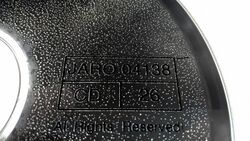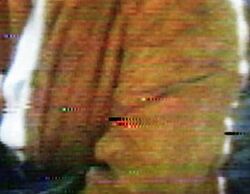Engineering:Disc rot
Disc rot is the tendency of CD, DVD, or other optical discs to become unreadable because of chemical deterioration. The causes include oxidation of the reflective layer, reactions with contaminants, ultra-violet light damage, and de-bonding of the adhesive used to adhere the layers of the disc together.
Causes
In CDs, the reflective layer is immediately beneath a thin protective layer of lacquer, and is also exposed at the edge of the disc. The lacquer protecting the edge of an optical disc can usually be seen without magnification. It is rarely uniformly thick; thickness variations are usually visible. The reflective layer is typically aluminium, which reacts easily with several commonly encountered chemicals such as oxygen, sulfur,[1] and certain ions carried by liquid water. In ordinary use, a surface layer of aluminium oxide is formed quickly when an aluminium surface is exposed to the atmosphere; it serves as passivation for the bulk aluminium with regard to many, but not all, contaminants. CD reflective layers are so thin that this passivation is less effective.[1] In the case of CD-R and CD-RW media, the materials used in the reflecting layer are more complex than a simple aluminium layer, but also can present problems if contaminated. The thin 0.25-0.5mm layer of protective lacquer is equivalent.
DVDs have a different structure from CDs, using a plastic disc over the reflecting layer. This means that a scratch on either surface of a DVD is not as likely to reach the reflective layer and expose it to environmental contamination and perhaps to cause corrosion, perhaps progressive corrosion. Since disc rot is often caused by the corrosion of aluminum, this means that DVDs are more resistant to disc rot. Each type of optical disc thus has different susceptibility to contamination and corrosion of its reflecting layer; furthermore, the writable and re-writable versions of each optical disc type are somewhat different as well. Finally, discs made with gold as the reflecting layer are considerably less vulnerable to chemical corrosion problems. Because they are less expensive, the industry has adopted aluminium reflecting layers as the standard for factory-pressed optical discs.[2]
Blu-rays, used to distribute movies (often as merchandise) and games, usually use a silver alloy layer instead of aluminum.[citation needed]
Signs of disc rot
On CDs, the rot becomes visually noticeable in two ways:
- When the CD is held up to a strong light, light shines through several pin-prick-sized holes.[3][4]
- Discoloration of the disc, which looks like a coffee stain on the disc. See also CD bronzing.[3][4]
In audio CDs, the rot leads to scrambled or skipped audio or even the inability to play the disc.
Using surface error scanning to check the data integrity allows discovering loss of data integrity before uncorrectable errors occur.[5][6]
Variants
Laser rot
Laser rot is the appearance of video and audio artifacts during the playback of LaserDiscs, and their progressive worsening over time.[4] It is most commonly attributed to oxidation in the aluminum layers by poor quality adhesives used to bond the disc halves together. Poor adhesives separate over time, which allows oxygen in the air to corrode the thin aluminum layer into aluminum oxide, visible as transparent patches or small dots in the disc. Corrosion is possible due to the thinness of the layer; normally aluminum does not corrode because it is coated in a thin oxide layer that forms on contact with oxygen. Single-sided video discs did not appear to suffer from laser rot while double-sided discs did. The name "laser rot" is not necessarily a misnomer; although the degradation does not involve the player's laser, the "rot" refers to the LaserDisc itself.[7]
Laser rot was indicated by the appearance of multi-colored speckles appearing in the video output of a LaserDisc during playback. The speckles increased in volume and frequency as the disc continued to degrade. Much of the early production run of MCA DiscoVision discs had severe laser rot. Also, in the 1990s, LaserDiscs manufactured by Sony's DADC plant in Terre Haute, Indiana, were plagued by laser rot.[4]
HD-DVD rot
Many HD-DVDs, especially those produced by Warner Bros. between 2006 and 2008 developed disc rot not long after production.[citation needed] Disc rot was also more common on double-sided HD-DVDs than on single-sided HD-DVDs.[citation needed]
See also
- CD bronzing, a type of disc rot, affecting a subset of CDs and DVDs, causing a bronze-colored darkening of the playable surface and eventual loss of readability.
- Conservation and restoration of plastic objects
- Data rot, a similar concept
- DVD-D and Flexplay, disposable optical disc formats designed to become unplayable after a limited time
- M-Disc, an optical disc format claimed to have a reduced rate of rot compared to conventional DVDs
- DVD § Disc quality measurements
- Compact disc § Integrity
References
- ↑ 1.0 1.1 Lampson, L. David (September 1995). "CD Bronzing". Classical.net. http://www.classical.net/music/guide/society/krs/excerpt3.html.
- ↑ "Longevity of Recordable CDS and DVDS - Canadian Conservation Institute (CCI) Notes 19/1 - Canada.ca". http://canada.pch.gc.ca/eng/1439925171172.
- ↑ 3.0 3.1 Tom Bishop (August 27, 2004). "Is music safe on compact disc?". BBC. http://news.bbc.co.uk/1/hi/entertainment/music/3940669.stm.
- ↑ 4.0 4.1 4.2 4.3 Ernie Smith (February 2, 2017). "When Discs Die". https://tedium.co/2017/02/02/disc-rot-phenomenon/.
- ↑ "QPxTool glossary". QPxTool. 2008-08-01. https://qpxtool.sourceforge.io/glossar.html.
- ↑ "How to Test the Burn Quality of CD/DVD Media". http://www.digitalfaq.com/guides/media/dvd-tests.htm.
- ↑ Bob Niland. Widescreen Review Laserdisc Magic 1998. p. 119.
External links
- Mac Observer article
- "CD Bronzing" article, with PDO replacement information, at Classical.net - How a manufacturing problem can cause disc quality degradation
- "Using CDs for Data Storage" article, with extensive footnoting.
(Wayback Machine copy)
- A bad case of DVD rot eats into movie collections
- Blu-ray rot on copies of The Prestige at AVS Forums
 |



